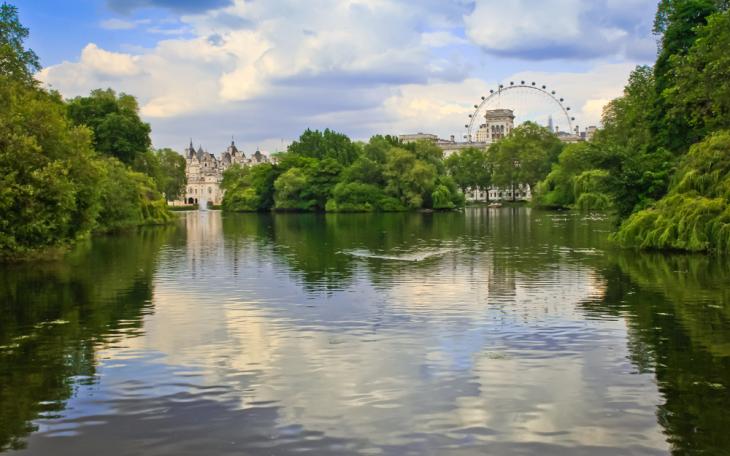London Wants to Be a Lighthouse for Green Cities Everywhere

In the virtue contest to become Europe’s “greenest city” London has one big natural advantage – it’s 35,000 acres of parks and green spaces. But The City square mile is, perhaps, its greatest environmental asset. This week at London Climate Action Week (LCAW), Mayor Sadiq Khan highlighted the capital’s pivotal role as a global “green financial centre.” According to City Hall, London’s green economy is worth more to the city than the construction and manufacturing sectors combined.
London’s mayor has rightly taken strong leadership on the climate emergency, committing to the ambitious goal of achieving net zero by 2030, through a range of initiatives including the “Retrofit Revolution” (a package of measures to help social landlords renovate their buildings to meet low-carbon standards), a plan to power the tube with renewable energy and investment into a solar power skills base in London. City Hall has just signed the Fossil Fuel Non-Proliferation treaty and has confirmed a new power purchase agreement tender to increase the use of renewable electricity across the capital’s transport network. In a bid to turn London into a smart city, a Chief Digital Officer, Theo Blackwell, has been appointed to see how intelligent data solutions can improve energy efficiency, air quality and the environment.
Khan is also the chair of the C40 Cities network, which brings the mayors of one hundred global cities together to take urgent action on climate change. One of his first moves was to launch the C40 Divest/Invest Forum to help cities to learn from each other, confront challenges and encourage action on fossil fuel divestment.
So far, so green and good. But how is London really measuring up in terms of sustainability and social equity compared to other major cities? One recent analysis, the Arcadis Sustainable Cities Index (SCI) 2022, ranked the UK’s capital sixth globally, behind Oslo, Stockholm, Copenhagen, Berlin and Tokyo. In other words, it has dropped back five places since 2018 when it was Number 1.
SCI scores cities according to its “three pillars of sustainability” - Planet, People and Profit. Predictably, it shows London doing reasonably well on Profit (which assesses the green business environment). More surprisingly, perhaps, it scores equally well on People (indicating quality of life, income and health equality etc.). It is not highly rated on Planet, however, which covers energy usage, emissions and transport, low-carbon infrastructure etc.
So where does London need to catch up? And what could it learn/borrow from other so-called green cities? The answer to these questions goes beyond the scope of this week’s blog, but here are some snapshots:
Transport:
In addition to the efforts underway to electrify, all of London’s buses are either hybrid or fully electric and twenty buses now run on renewably produced hydrogen. Other cities - notably German cities like Hamburg - have been bolder with hydrogen mobility pilots, however. But the main reason the top three Scandinavian cities have overtaken London is because they have powerful incentives to encourage EV drivers and disincentives for owners of fossil fuel cars and fleets. Over 50% of all new cars sold in Norway in 2020 were fully electric, for example. This would seem an easy one to fix.
Then there’s the EV charging infrastructure. London is supposed to have 5,000 rapid charging points and c. 2,700 slower charging points. It sounds like a lot but the reality for users is less than acceptable. Last year, for example, the taxi firm Addison Lee reported that 93% of its drivers said finding rapid charging points was “not easy” and more than half reported them to be broken or damaged.
TfL has pledged to deliver enough cycleways to connect-up a third of Londoners by 2025 and is more or less on track – the number of people commuting by bike is steadily growing. However, London could be innovating more with light electric vehicles (such as e-cargo bikes) for “last mile” deliveries and private hire, following in the footsteps of other cities like Amsterdam, Munich, and Brighton. Here the private sector could be doing more.
Buildings:
London’s buildings are responsible for a staggering 78% of the capital’s carbon emissions (38% of its emissions come from heating and powering homes and 36% from places of work). A high proportion of its buildings are heritage – in other words, leaky housing stock – in a crowded, built-up environment. Considering the scale of the challenge, Khan has done his best to reduce emissions with regulation to ensure new construction projects are low-carbon compliant and his Retrofit Revolution to modernise social housing. However, there is a huge gap between the funding that’s been secured for housing (£160m) and what is needed (a substantial chunk of City Hall’s £61bn target for buildings and infrastructure).
National and local government must collaborate more with solutions providers to help SMEs (accounting for half of all company emissions nationally) and households decarbonise. Greater incentives and attractive business models are what’s needed to get Britain’s landlords and business owners to insulate and upgrade with clean energy systems including solar panels, CHP, hydrogen boilers and heat pumps.
But there are simpler way to reduce emissions that will come from culture change within companies. Two years of the pandemic radically altered the way we work – hybrid working is now broadly accepted, indeed often preferred. The power is in the hands of business owners to build back better, with more energy and resource efficiency, less waste and a circular approach to products and services.
Social and Environmental levelling up:
London’s Grow Back Greener initiative to create a healthier, tree-lined London and provide outdoor spaces for the majority of Londoners who don’t have access to gardens has been a success. Nonetheless, City Hall could do more to deliver clean air equality and tackle fuel poverty and the cost-of-living crisis that is hitting hard. Initiatives like the Low Traffic Neighbourhoods – where certain roads are closed to traffic to create “neighbourhood streets” and encourage cycling – have proved controversial and divided residents of certain boroughs who claim they are creating “pollution ghettos.” Smart technology to monitor local air quality and map fuel poverty in real time would help to unravel these complex issues.
London has a mountain to climb in the next few decades – from infrastructure to air quality and waste disposal. City Hall is the first to admit it; it has stated the city only has half the resources it needs to become truly zero-carbon. The rest must come from either UK Gov (by funding and empowering local authorities to take more action) or from private sector investment. It’s time for green venture capitalists and innovative companies to invest in a more sustainable future for all Londoners.
Home | London Climate Action Week
Environment | London City Hall
Divesting from Fossil Fuels, Investing in a Sustainable Future Accelerator - C40









